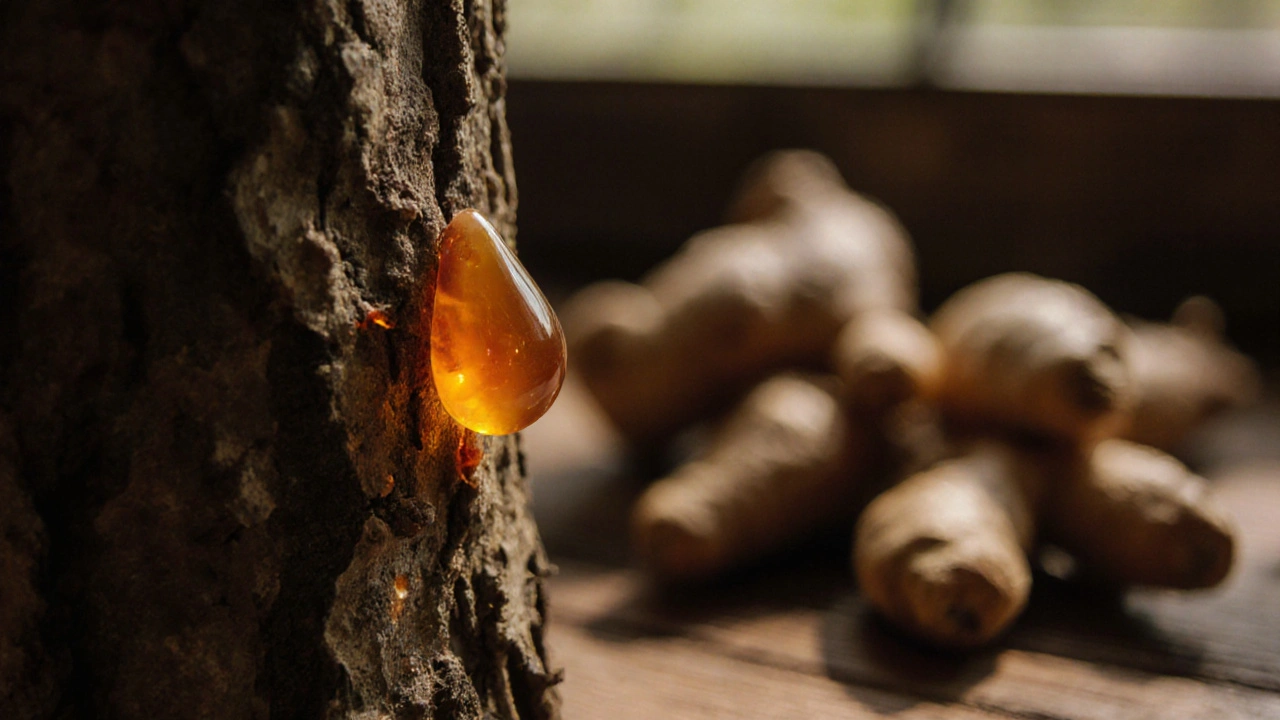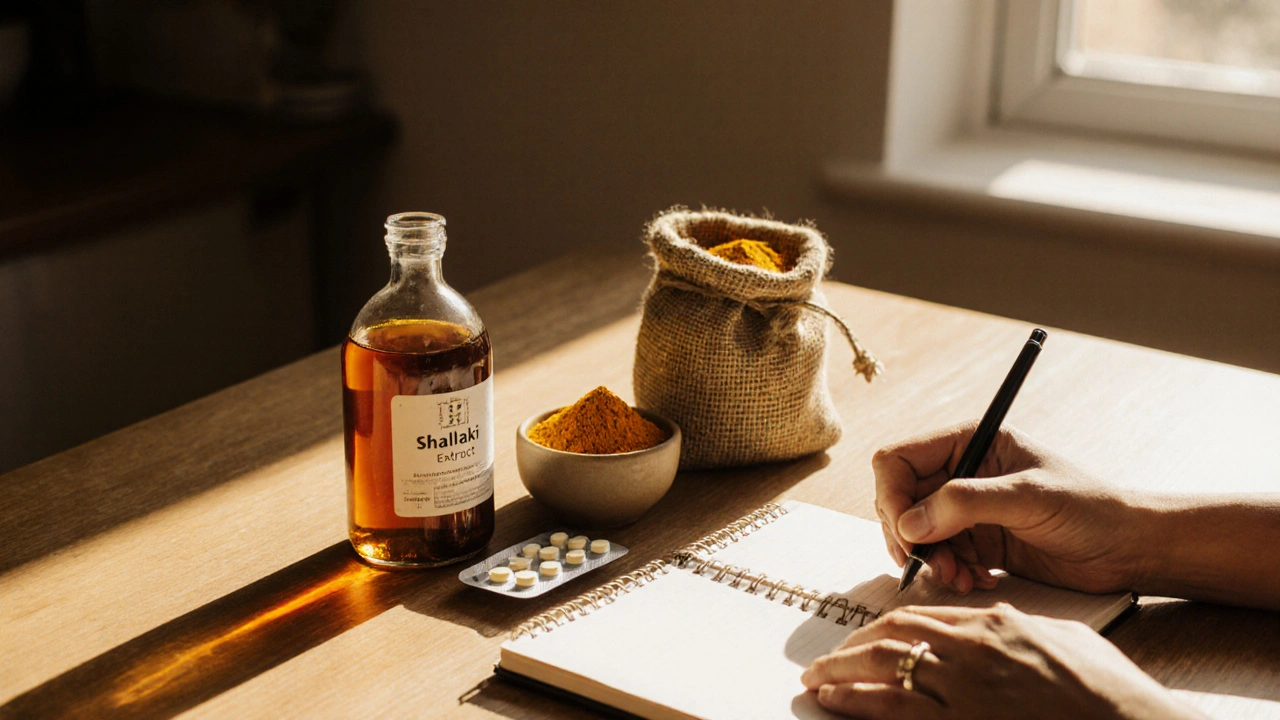Shallaki (Boswellic Acid) vs. Common Anti‑Inflammatory Alternatives: A Detailed Comparison
 Oct, 8 2025
Oct, 8 2025
Shallaki vs. Anti-Inflammatory Alternatives Comparison Tool
Compare Active Compounds & Mechanisms
Select two supplements to compare their key attributes:
Detailed Comparison Table
| Attribute | Shallaki (Boswellic Acid) | Turmeric (Curcumin) | Ginger | Frankincense Oil | Ibuprofen (NSAID) |
|---|---|---|---|---|---|
| Primary Active Compound | Acetyl-11-keto-beta-boswellic acid (AKBA) | Curcumin | Gingerols & shogaols | Alpha-pinene & incensole | Ibuprofen |
| Typical Oral Dose | 300–500 mg extract (~30% AKBA) 2–3×/day | 500–1000 mg standardized (≈95% curcuminoids) 1–2×/day | 500–1000 mg ginger powder 2×/day | 300–600 mg extract 2×/day (research-grade) | 200–400 mg every 4–6 h (max 1200 mg/day) |
| Key Anti-Inflammatory Pathway | 5-LOX inhibition | NF-κB & COX-2 inhibition | COX-1/2 & 5-LOX inhibition | Partial 5-LOX & COX modulation | COX-1 & COX-2 inhibition |
| Clinical Evidence Level | Moderate – 10+ RCTs on OA, IBD | High – 30+ RCTs on inflammation | Moderate – 15+ RCTs on pain & nausea | Low – Limited oral research | High – Extensive clinical data |
| Cost Per Month | $15–$30 | $10–$25 | $15–$20 | $20–$40 | $5–$15 |
| Stomach Tolerance | Excellent – Minimal GI side effects | Good – Needs piperine or special formulation | Excellent – Gentle on stomach | Unknown – Topical only | Poor – Risk of GI bleeding |
When you search for a natural way to calm joint pain or chronic inflammation, Shallaki is often at the top of the list. But how does it really stack up against other popular options like turmeric, ginger, frankincense oil, or even over‑the‑counter NSAIDs? This guide breaks down the science, typical dosages, costs, and real‑world experiences so you can decide which supplement-or drug-fits your lifestyle best.
Key Takeaways
- Shallaki’s main active compounds, boswellic acids, inhibit 5‑LOX similarly to some prescription drugs but with fewer stomach issues.
- Turmeric (curcumin) offers broader antioxidant benefits but is less potent for acute joint flare‑ups.
- Ginger provides comparable anti‑inflammatory effects to low‑dose NSAIDs and is gentle on the gut.
- Frankincense oil (alpha‑pinene) works well for localized skin applications but lacks robust oral research.
- Cost per month ranges from $15 for ginger powder to $60 for premium Boswellia extracts; price often reflects extraction purity.
What is Shallaki?
Shallaki (also called Boswellia serrata) is a resin‑derived supplement harvested from the Indian frankincense tree. The resin contains a family of molecules known as boswellic acids, the most studied of which is acetyl‑11‑keto‑beta‑boswellic acid (AKBA). Traditionally used in Ayurvedic medicine, modern studies link boswellic acids to reduced leukotriene production, lower cytokine levels, and improved joint mobility.
How Boswellic Acid Works
Think of inflammation as a fire that burns your joints. Boswellic acids act like a fire‑retardant: they block the 5‑lipoxygenase (5‑LOX) pathway, which produces leukotrienes-the chemicals that fan the flame. Unlike NSAIDs that inhibit COX enzymes (often causing stomach irritation), boswellic acids spare the stomach lining in most users. Typical oral dosages range from 300mg to 500mg of standardized extract (containing ~30% AKBA) taken two to three times daily.

Popular Alternatives
Below are the most common natural and pharmaceutical options people compare with Shallaki.
Turmeric (Curcuma longa)
Turmeric is a bright yellow spice whose active ingredient, curcumin, blocks NF‑κB and COX‑2 pathways. While it offers antioxidant protection, curcumin’s bioavailability is notoriously low unless paired with piperine or formulated as a phytosome.
Ginger (Zingiber officinale)
Ginger contains gingerols and shogaols that inhibit COX‑1, COX‑2, and 5‑LOX. It’s often praised for easing muscle soreness after exercise and for being easy on the stomach.
Frankincense Oil (Boswellia sacra)
Frankincense oil is distilled from the resin of Boswellia sacra. When applied topically, it delivers terpenes like alpha‑pinene that have modest anti‑inflammatory and analgesic effects, but oral data remain limited.
Non‑steroidal Anti‑Inflammatory Drugs (NSAIDs)
Ibuprofen and similar NSAIDs inhibit COX enzymes directly, providing quick pain relief. The trade‑off is higher risk of gastrointestinal bleeding, kidney strain, and cardiovascular events when used long‑term.
Glucosamine &MSM
These compounds are cartilage‑building supplements. They don’t directly suppress inflammation but may improve joint cushioning over months of consistent use.
Side‑by‑Side Comparison
| Attribute | Shallaki (Boswellic Acid) | Turmeric (Curcumin) | Ginger | Frankincense Oil (Oral) | Ibuprofen (NSAID) |
|---|---|---|---|---|---|
| Primary active compound | Acetyl‑11‑keto‑beta‑boswellic acid (AKBA) | Curcumin | Gingerols & shogaols | Alpha‑pinene & incensole | Ibuprofen |
| Typical oral dose | 300‑500mg extract (≈30% AKBA) 2‑3×/day | 500‑1000mg standardized (≈95% curcuminoids) 1‑2×/day | 500‑1000mg ginger powder 2×/day | 300‑600mg extract 2×/day (research‑grade) | 200‑400mg every 4‑6h (max 1200mg/day) |
| Key anti‑inflammatory pathway | 5‑LOX inhibition | NF‑κB & COX‑2 inhibition | COX‑1/2 & 5‑LOX inhibition | Partial 5‑LOX & COX modulation | COX‑1 & COX‑2 inhibition |
| Evidence level (clinical trials) | Moderate - 10+ RCTs on OA, IBD | High - 30+ RCTs on inflammation | Moderate - 15+ RCTs on pain & nausea | Low - <5 small pilot studies | High - decades of data, FDA‑approved |
| Common side effects | Rare stomach upset, allergic rash | Gastro‑intestinal upset at high doses | Heartburn, mild diarrhea | Skin irritation (topical), rare GI | Stomach ulcer, kidney strain, increased BP |
| Cost per month (US$) | 45‑60 (standardized extract) | 20‑35 (generic powder) | 15‑25 (powder) | 50‑70 (research grade) | 10‑15 (generic 200mg tablets) |
| Best for | Chronic joint inflammation, IBD, asthma | Broad anti‑oxidant support, mild inflammation | Post‑workout soreness, nausea, quick relief | Topical joint discomfort, aromatherapy | Acute pain, fever, short‑term inflammation |
Pros and Cons at a Glance
- Shallaki:
- Pros - Targets 5‑LOX, good for long‑term joint health, low GI risk.
- Cons - Higher price, needs standardized extract for effect.
- Turmeric:
- Pros - Strong antioxidant profile, many formulations.
- Cons - Poor absorption without piperine, less potent on acute flare‑ups.
- Ginger:
- Pros - Fast acting, inexpensive, gut‑friendly.
- Cons - Requires multiple doses, taste may be strong.
- Frankincense Oil (oral):
- Pros - Natural resin, pleasant aroma, useful for skin.
- Cons - Limited oral research, can be pricey.
- Ibuprofen:
- Pros - Immediate relief, widely available.
- Cons - GI and cardiovascular risks with long use.

How to Choose the Right Anti‑Inflammatory Supplement
- Identify your primary goal. Are you managing chronic arthritis, seeking post‑exercise recovery, or need occasional pain relief?
- Check bioavailability. Boswellic acid extracts that list % AKBA and use a carrier (e.g., black pepper, liposomal) are more reliable.
- Consider tolerance. If you’ve had stomach ulcers, avoid high‑dose NSAIDs and lean toward Shallaki or ginger.
- Budget matters. A month‑long trial of each supplement can reveal personal response without breaking the bank.
- Look for third‑party testing. Independent labs (e.g., NSF, Informed‑Sport) reduce the risk of contamination.
Potential Pitfalls & Troubleshooting
If you start a new supplement and don’t notice improvement after 4‑6 weeks, consider these steps:
- Verify dosage-many products under‑label the actual AKBA content.
- Combine with a complementary agent. For example, pairing Shallaki with turmeric can cover both 5‑LOX and COX pathways.
- Check interactions. Boswellic acid may enhance blood‑thinning effects of warfarin or aspirin.
- Switch form if GI upset occurs-capsules often cause less irritation than raw resin powder.
Frequently Asked Questions
Is Shallaki safe for long‑term use?
Most clinical trials lasting up to 12 months report no serious adverse events. Mild stomach discomfort can occur, so taking it with food is advisable. People on blood thinners should consult a doctor.
How does the effectiveness of Boswellic Acid compare to ibuprofen?
Ibuprofen provides faster pain relief because it blocks COX enzymes directly, while Boswellic Acid works more slowly by dampening leukotriene production. For chronic conditions, Boswellic Acid often shows comparable pain reduction with fewer gastrointestinal side effects.
Can I take Shallaki together with turmeric?
Yes. The two target different inflammatory pathways, so stacking can provide broader coverage. Start with low doses of each to gauge tolerance.
What’s the best time of day to take Boswellic Acid?
Split the daily dose into two or three servings with meals. This improves absorption and lessens any occasional stomach upset.
Are there any notable drug interactions?
Boswellic Acid can boost the effect of anticoagulants (warfarin, aspirin) and may interfere with corticosteroid metabolism. Always discuss with a healthcare professional before combining.
Next Steps
Pick one alternative that aligns with your health goal, purchase a reputable brand, and stick with the recommended dose for at least a month. Track pain levels, joint flexibility, and any side effects in a simple log. If results plateau, consider adding a second complementary supplement or switching to a higher‑purity Boswellic Acid extract.
Dheeraj Mehta
October 8, 2025 AT 18:20Shallaki looks promising for joint health 😊. It offers a decent alternative for those who can’t tolerate NSAIDs.
Oliver Behr
October 11, 2025 AT 15:47In Ayurvedic tradition, boswellia has been used for centuries to support inflammation.
Tiffany W
October 14, 2025 AT 13:13The pharmacodynamic profile of boswellic acids demonstrates selective 5‑LOX inhibition, which attenuates leukotriene biosynthesis. However, oral bioavailability remains a limiting factor, necessitating high‑purity extracts. Curcumin, by contrast, suffers from rapid glucuronidation unless co‑administered with piperine. Comparative RCTs often suffer from heterogenous dosing regimens, compromising meta‑analytic validity. Ethically, one must weigh the modest efficacy against potential herb‑drug interactions.
Rajeshwar N.
October 17, 2025 AT 10:40The tables gloss over the fact that many of the cited studies are underpowered and lack long‑term safety data. Moreover, extraction methods vary wildly, so a $20 bottle may not even contain the purported AKBA percentage.
Louis Antonio
October 20, 2025 AT 08:07Yeah, just pop a handful of herbs and expect miracles-reality check: you still need proper rehab and diet.
Kyle Salisbury
October 23, 2025 AT 05:33I’ve observed regional variations in extract standardization that affect outcomes; manufacturers in different countries use distinct solvent systems.
Angie Robinson
October 26, 2025 AT 03:00The cost‑benefit ratio fails when you compare AKBAs to cheap NSAIDs that achieve comparable COX inhibition at a fraction of the price.
Emmons Kimery
October 29, 2025 AT 00:27You raise a good point, but also consider patient tolerance 👍🙂. Many users report minimal GI upset, which is a real advantage over ibuprofen.
Mimi Saki
October 31, 2025 AT 21:53Great rundown!
Subramaniam Sankaranarayanan
November 3, 2025 AT 19:20Boswellia serrata extracts have been investigated across a spectrum of inflammatory disorders, ranging from osteoarthritis to inflammatory bowel disease. The active constituent, acetyl‑11‑keto‑beta‑boswellic acid (AKBA), exerts its effect primarily through inhibition of the 5‑lipoxygenase pathway, thereby reducing leukotriene synthesis. This mechanism differentiates it from classic NSAIDs, which target cyclooxygenase enzymes and consequently pose a higher risk of gastric mucosal injury. Clinical trials have demonstrated modest improvements in pain scores, typically measured by the WOMAC index, when dosed at 300‑500 mg two to three times daily. However, the heterogeneity of study designs, including variation in extract standardization (30 % versus 65 % AKBA), complicates direct comparison. Bioavailability remains a concern; lipid‑based formulations have shown up to a two‑fold increase in plasma AKBA levels compared to standard capsules. Safety data are relatively encouraging, with most adverse events limited to mild gastrointestinal discomfort, though rare cases of hepatic enzyme elevation have been reported. When juxtaposed with ibuprofen, Boswellia offers a lower incidence of ulcerogenic potential, but the analgesic potency is generally less immediate. Cost analysis indicates a monthly expense of $15‑$30 for quality extracts, which may be prohibitive for some patients without insurance coverage. From a mechanistic standpoint, the addition of Boswellia to a multimodal regimen can synergize with turmeric’s NF‑κB inhibition, potentially yielding broader anti‑inflammatory coverage. Nevertheless, clinicians should remain vigilant for potential herb‑drug interactions, particularly with anticoagulants, due to the modest antiplatelet effects observed in vitro. Long‑term studies beyond six months are sparse, leaving uncertainty about sustained efficacy and safety. Patient adherence can also be challenged by the pill burden required to achieve therapeutic AKBA concentrations. Ultimately, Boswellia may serve as a viable adjunct for individuals seeking a gentler alternative to chronic NSAID use, provided they are educated about realistic expectations.
Kylie Holmes
November 6, 2025 AT 16:47If you’re on the fence, give Shallaki a trial for eight weeks and track your joint pain on a simple visual analog scale.
Jennifer Wees-Schkade
November 9, 2025 AT 14:13Clinicians should monitor liver enzymes when prescribing high‑dose Boswellia, especially in patients with pre‑existing hepatic conditions, and advise against concurrent use with anticoagulants without supervision.
Fr. Chuck Bradley
November 12, 2025 AT 11:40Wow, this table looks like a battlefield of supplements, each fighting for the crown of “best anti‑inflammatory.”
Patrick Rauls
November 15, 2025 AT 09:07lol u r right, i think the real winner is the one that doesnt upset ur stomach.
Asia Lindsay
November 18, 2025 AT 06:33Keep exploring, remember every body reacts differently, and a balanced diet can amplify any supplement’s benefit.
Angela Marie Hessenius
November 21, 2025 AT 04:00When I first encountered Boswellia in a small village in Rajasthan, the local healer offered me a resin tincture that smelled of ancient incense, promising relief from the arthritis that had plagued my grandfather. He explained that the resin, harvested from the bark of the Boswellia tree, had been part of Ayurvedic pharmacopeia for millennia, a tradition that predates even the earliest Greek texts on medicine. Over the years, Western researchers have attempted to distill that ancient wisdom into standardized extracts, yet the journey from forest to pharmacy shelf introduces variables-soil composition, altitude, drying method-that inevitably alter the phytochemical profile. Modern chromatography reveals that AKBA content can swing by as much as forty percent between batches, a fact that most consumers remain blissfully unaware of. Moreover, the regulatory landscape treats these extracts as dietary supplements, meaning rigorous Good Manufacturing Practices are not uniformly enforced, and batch‑to‑batch consistency may be more aspirational than actual. Nevertheless, the mechanistic intrigue of a plant‑derived 5‑LOX inhibitor continues to captivate both clinicians and patients seeking a gentler alternative to synthetic NSAIDs. In practice, many individuals adopt Boswellia alongside a holistic regimen that includes weight management, low‑impact exercise, and anti‑oxidant‑rich foods, thereby creating a synergistic matrix of interventions. It is also worth noting that the oral bioavailability of AKBA can be enhanced through piperine co‑administration or lipid‑based delivery systems, a nuance that underscores the importance of formulation science in translating tradition into therapeutic reality. While the evidence base is solidifying, gaps remain-long‑term safety data beyond a year are still scarce, and head‑to‑head trials against high‑dose ibuprofen are few. Patients considering Boswellia should therefore engage in a frank dialogue with their healthcare provider, discussing any concurrent medications, especially antihypertensives or blood thinners. Ultimately, the decision to incorporate this resin into one’s anti‑inflammatory arsenal rests on a balance of personal tolerance, cost considerations, and the philosophical comfort of aligning with a botanical lineage that has weathered centuries of human experience.